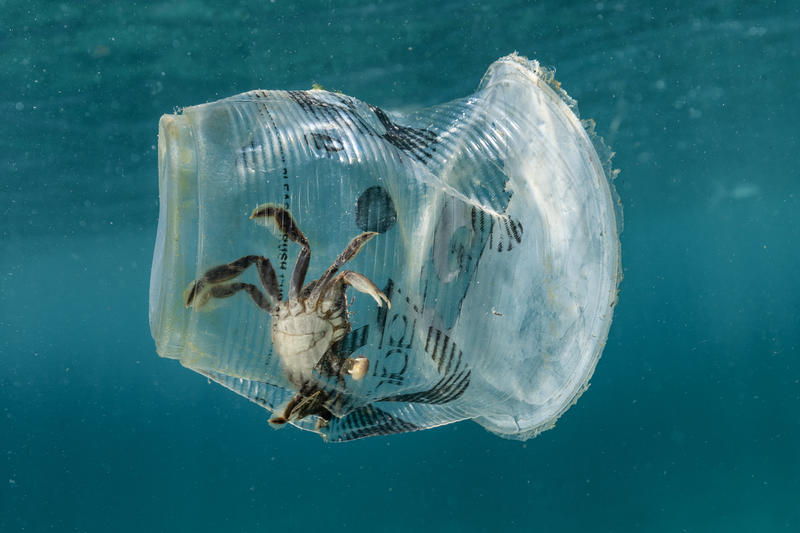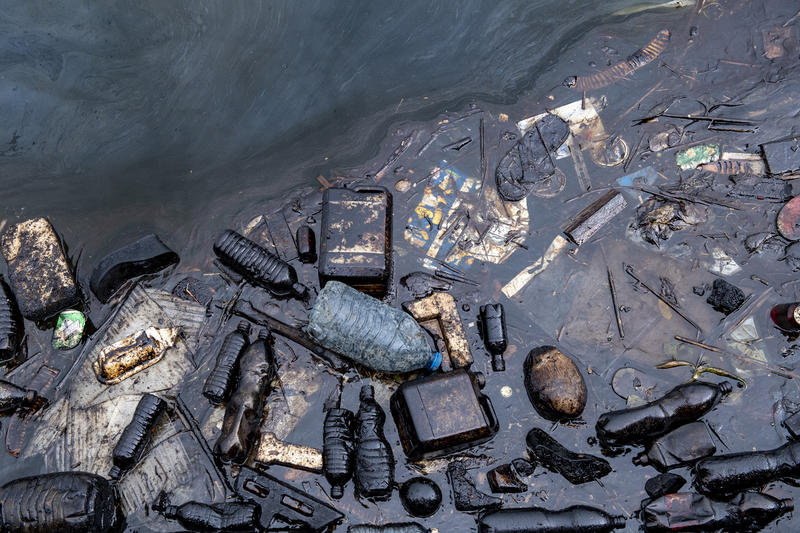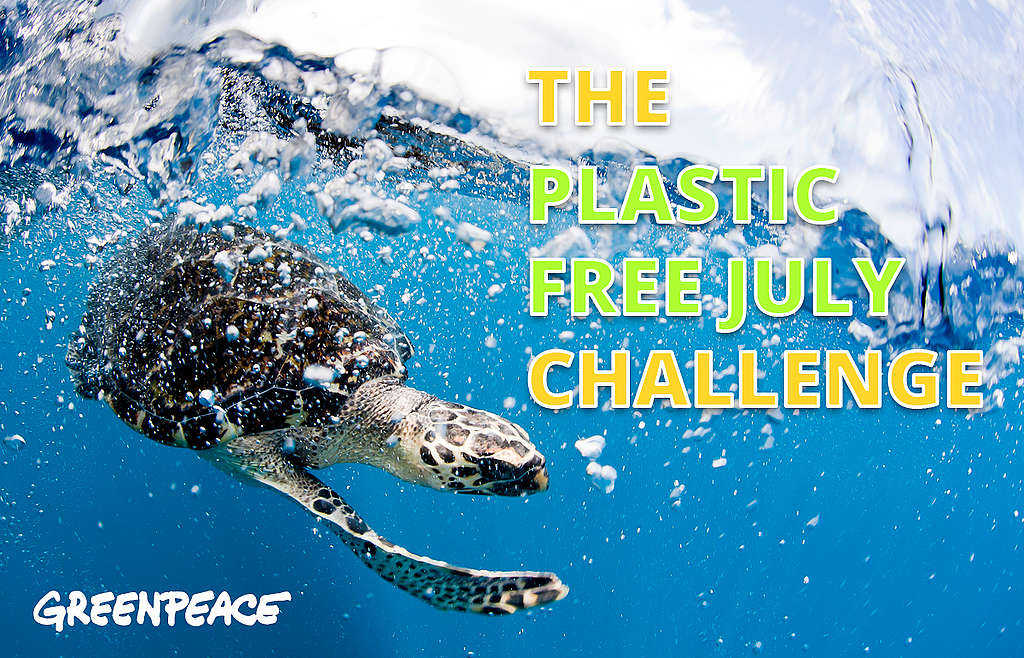At the start of Plastic Free July, the question on many people’s minds is this: How do I go plastic free? How can I use less plastic – for a day, for a month, for a year, for good!
It’s a great question. Plastic pollution is contaminating our world in the most insidious ways. It’s in our rivers and the ocean, at the tops of mountains and in the deep sea, it’s in our food and it’s in our bodies. Plastic kills wildlife, and it keeps killing because it doesn’t ever leave us, it just gets smaller and more difficult to detect as micro-plastic.
We live in a broken system, where corporations create and perpetuate a throwaway culture to plague our world with disposable products, giving us virtually no choice but to purchase plastics in some way.
Our oceans are slowly turning into a plastic soup, and the effects on ocean life are chilling. Discarded plastic fishing lines trap and entangle turtles and seabirds, and plastic pieces of all sizes choke and clog the stomachs of creatures who mistake it for food, from tiny zooplankton to whales. Plastic is now entering every level of the ocean food chain and is even ending up in the seafood on our plates.

It is hideous, but before you go off and spend the plastic-free July working out how to recycle more and use less plastic, consider this.
Big polluters love recycling schemes
The big plastic producers, and the oil companies that rely on them as the world turns against fossil fuels … they love recycling.
Shell, Exxon Mobil, BP and INEOS would LOVE you to spend all your time sorting through your plastic, washing plastic bottles, educating your friends about what plastic can be recycled, and berating uncle Bob about his poor recycling habits.
They also don’t mind if you spend lots of time and money finding clever ways to use less plastic, like glass keep cups, metal straws and bamboo toothbrushes – because they know that while we let them continue producing masses of cheap throwaway plastic, the alternatives can’t really compete in a meaningful way.
But what they’re really scared you’ll do is start working together to end their business model altogether. That terrifies them. They’ve seen how effective we can be when we stand together.
Big Oil and its horrible twin Big Plastic are horrified by the prospect that we all stop worrying so much about recycling and join together to change the system they rely on.

They’re scared because they’ve seen it work. By working together and focusing on systemic change, we won a ban on single use plastic shopping bags which since it came into force, has seen billions fewer bags thrown away to pollute the world for eons to come.
That really shook them up.
Now we’re focusing on one of the worst plastic pollution culprits – single-use plastic drink bottles. It’s estimated that every year in Aotearoa we toss away more than a billion plastic bottles.
This plastic ends up clogging our landfills, getting shipped offshore and incinerated in places like Malaysia, where it harms human health, or it winds up on our coast, causing harm to wildlife and breaking down into tiny toxic pieces which end up in our food.
It’s time to ban the bottle. Sign the petition here.
And now, before we go on to the top 7 ways to use less plastic, the main thing is to do it proudly and visibly. One of the best things about walking the talk is that it normalises the shift, and that makes it more likely that people join the movement to create systemic change!
We need collective and individual action.
Individual action makes people think, shows what we can do, reminds decision makers that there is a will to change and highlights the systems shifts needed to enable more to follow.
And one last thing before we get to the handy list, it’s important to keep in mind when going into the Plastic Free July commitment, that reducing plastic in our lives, even just for one month, can be very difficult and time-consuming. For many people, plastic-free options are not feasible, accessible, or affordable. We are living in a broken system, and to combat the issue of plastic pollution, we need to stop plastics at the source. If your bathtub was overflowing, you wouldn’t immediately reach for a mop. You would first turn off the tap. That’s what we need to do with plastics.
7 ways to go plastic free in the Plastic Free July Challenge

1. Participate in Plastic Free July!
All you have to do is commit to one month of trying to avoid disposable plastic. You can challenge yourself and commit to different levels.
- Beginner: You can pick one disposable item to avoid all month, like single-use plastic bottles, coffee cups, or vegetable bags at the supermarket and form a new solid habit of using your own reusables!
- Intermediate: You can commit to eliminating all those top three (single-use plastic bottles, coffee cups, vegetable bags) or another mixture of single-use plastic items you notice frequently popping up in your lifestyle.
- Expert: You can go all in and avoid all disposable plastic all month!
The great thing about Plastic Free July is that it’s only a month-long commitment. It gives us the opportunity to challenge ourselves to do better on the individual level and see if the lifestyle changes are something we can commit to in the long term.
The more visible you are with your efforts, the more you can inspire others and show decision makers that it’s something we want, so talk about it to friends and family, post about it on social media, let people know how you get on, whether you s쳮d or not.
2. Try Zero Waste living
It’s always good to think holistically and reducing plastic waste is no different. In 2015, Hannah and Liam started a zero waste living journey by simply living without a rubbish bin.
In their first five years of zero waste living they sent just 7.6kg of rubbish to landfill. They limited their recycling to two wheelie bins of paper and cardboard, and eight crates of glass. They’re pretty hard core, and now spend a lot of time educating others about what’s possible. You can read Hannah’s top 10 tips for zero waste living here.
3. Lobby your local council or businesses to eliminate single-use plastics
One of the best ways to make change is to lobby at the local level. Your elected officials represent you. Listening to you is literally their job, so let them know what you think! Here are a few ways you can tell them that single-use plastics aren’t welcome in your community, and to use grassroots activism to strengthen democracy at the same time.
Here’s some ways to lobby decision makers to go plastic free
Write an email or letter
Writing a personal letter or email is a better way to get your point across than contacting an official through their website. It’s harder for them to ignore a message in their mailbox or inbox, which means you’re more likely to get a response. Here is a TEMPLATE that you can modify and use. Be sure to identify yourself as a constituent, include your name and address, and personally sign the letter. Encourage others to do the same. The more they hear the same message, the more likely they are to listen.
Make a phone call
Find your voice and pick up the blower. Calling your elected officials is a great way to make a personal connection with them or their staff. Here is a sample PHONE SCRIPT that you can modify and use. Again, be sure to let them know that you’re a constituent—they want your vote, after all! And talk to your friends and family about calling, too.
Start an ongoing campaign with a petition
Thanks to the internet, it’s easier than ever to start a petition. First, identify the target of your petition—the official you want to take action— and clearly state your demands. Here is a sample PETITION that you can adjust to suit your needs. Then, head over to our community petition platform and set up your petition. Share your petition on social media and ask your friends to do the same. Once you have a solid number of signatures, deliver the petition to your local decision maker. Email is easiest, of course, but sometimes visiting their office, and handing it to them in person will make a bigger impression.
4. Choose to refuse single-use takeaway cups
Most coffee cups aren’t recycled. By bringing your own reusable coffee cup, or taking the time to dine-in at your favourite café, you can make a huge difference. You can easily avoid takeaway coffee cups by bringing along your own reusable alternative. There are many reusable coffee cups available on the market. Keep it in your bag or on your desk at work; wherever you’ll remember to use it.
5. Choose to refuse pre-packed fruit and vegetables.
Many grocery stores pre-package their fruit and vegetables in plastic, and offer plastic bags for loose items. There are simple alternatives to help reduce your impact on the environment. Buying plastic-wrapped or packaged fruits and vegetables can be convenient, but unfortunately it creates plastic waste. Instead, look out for loose fruit and vegetables in your local grocery store, or head to a farmers market or organic store where plastic packaging is less often used. Choose lightweight, reusable produce bags instead of the plastic bags that are usually provided. Be sure to look for ones made from recycled plastic or repurposed netting fabric.
6. Choose to refuse single-use plastic dental products.
You can go plastic-free with your dental care, by finding more sustainable alternatives to toothbrushes, toothpaste, and dental floss. More and more people are choosing toothbrushes that are made from sustainable, compostable materials, such as bamboo. Be aware though, bristles are usually still made from plastic, so you’ll need to cut them off before composting or reusing your bamboo toothbrush handle. Purchasing a toothbrush with a replaceable head can eliminate the need to continually purchase a new plastic brush every few months, too. When it comes to toothpaste, many health and organic stores sell plastic-free alternatives. There are also recipes available online for making your own.
7. Buy less
Before making a purchase, smart shoppers stop and think: Is there a better alternative? Do I need this? Or, do I need this much? People making smarter decisions when shopping show that it can have a huge impact, and is not too difficult. Considering the packaging of the item is a good place to start to ‘buy less’. Thinking about potential alternatives can include: choosing the item with the least amount of packaging, switching from plastic to paper packaging, or even choosing loose product with no packaging at the grocers or a bulk food store. For reusable products it’s better to purchase something that’s designed to last forever than it is to purchase something that will need replacing regularly.
This handy list was selected from the Plastic Free July website, and there are plenty more here if you’re still hungry for tips on how to go plastic free!

Call on the NZ Government to ban unnecessary single-use plastic bottles* in NZ, and to incentivise reusable and refillable alternatives.
Take Action


